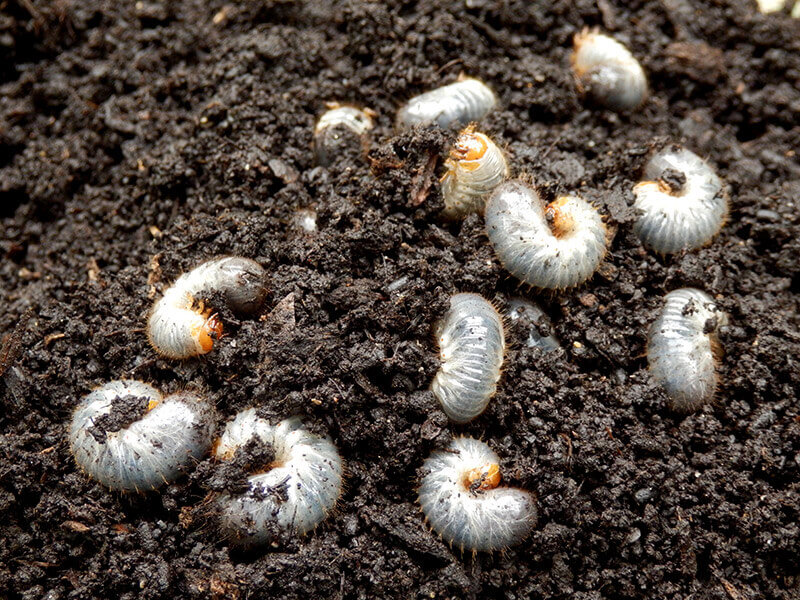Spring is finally here, and along with the beautiful weather and green lawns come the inevitable pests. Per the U.S. Department of Agriculture, pests cause more than 200 million dollars’ worth of turf damage annually! One of the main culprits? White grubs, inconspicuous pests that do their damage under cover. Don’t let your lawn be part of the statistic; learn a little about this pest to limit your chances of serious lawn destruction this season!
Know Your Sneaky Pest
 Grubs are the larvae stage of several types of beetles, two of which are well-known to most of us as the Japanese beetle and the June bug. Both prefer sunny lawns with moist soil and are especially attracted to lawns that are watered regularly during the hot and dry periods. During mid and late summer, the beetles are ready to lay their eggs underground, leaving them to hatch into young grubs amongst the grass roots. This allows the hungry little grubs to feast on your lawn’s succulent roots. What’s good for the grubs’ growth is detrimental to your lawn! They continue feasting through the fall, and that’s when they do the most damage. As winter approaches, they dig down as deep as one foot, escaping from the cold and becoming inactive for the winter. In the spring, they become active again and continue to dine on your lawn’s roots. This seasonal cycle continues for three years until the grubs reach maturity. They then become beetles and fly into your garden for a different type of meal, and so the cycle continues.
Grubs are the larvae stage of several types of beetles, two of which are well-known to most of us as the Japanese beetle and the June bug. Both prefer sunny lawns with moist soil and are especially attracted to lawns that are watered regularly during the hot and dry periods. During mid and late summer, the beetles are ready to lay their eggs underground, leaving them to hatch into young grubs amongst the grass roots. This allows the hungry little grubs to feast on your lawn’s succulent roots. What’s good for the grubs’ growth is detrimental to your lawn! They continue feasting through the fall, and that’s when they do the most damage. As winter approaches, they dig down as deep as one foot, escaping from the cold and becoming inactive for the winter. In the spring, they become active again and continue to dine on your lawn’s roots. This seasonal cycle continues for three years until the grubs reach maturity. They then become beetles and fly into your garden for a different type of meal, and so the cycle continues.
Evidence of Grub Damage
 If you have wildlife (such as raccoons and skunks) digging up your lawn at night, they may be after a yummy snack of grubs. Once grass roots are gone, they don’t grow back, causing dry brown patches of grass. These brown grass areas may feel spongy when you walk on them. You can investigate further by checking the root zone of the sod. Peel back the sod: if it lifts easily, that’s never a good sign, but it may not mean you’re infested with grubs. You’ll need to look for them closely; they’re white and about a half-inch in length with a dark head and legs, and when disturbed they curl into a C-shape. If you find one or two just below the lifted sod, go a little further, digging down another one to two inches. If you find more than three or four grubs within a square foot area, your lawn is infested, and you’ll need help! Once you see the damage, it’s far too late to control. Additionally, the damaged area will not recover because the root system is dead.
If you have wildlife (such as raccoons and skunks) digging up your lawn at night, they may be after a yummy snack of grubs. Once grass roots are gone, they don’t grow back, causing dry brown patches of grass. These brown grass areas may feel spongy when you walk on them. You can investigate further by checking the root zone of the sod. Peel back the sod: if it lifts easily, that’s never a good sign, but it may not mean you’re infested with grubs. You’ll need to look for them closely; they’re white and about a half-inch in length with a dark head and legs, and when disturbed they curl into a C-shape. If you find one or two just below the lifted sod, go a little further, digging down another one to two inches. If you find more than three or four grubs within a square foot area, your lawn is infested, and you’ll need help! Once you see the damage, it’s far too late to control. Additionally, the damaged area will not recover because the root system is dead.
Successfully Treating a Grub Infestation
You found grubs, so now what? Many homeowners attempt to treat the problem themselves, with varying degrees of success. The process can be quite demanding; treatment of grubs is ongoing, not a one-and-done pesticide application. Treatments applied by professionals tend to be much more successful, and there are various pesticides that can be used. Our licensed and experienced professionals know lawns and the pests that infest them. You can rely on ProLawnPlus to choose the correct treatment for your lawn, and we always keep your children and pets’ wellbeing in mind.

